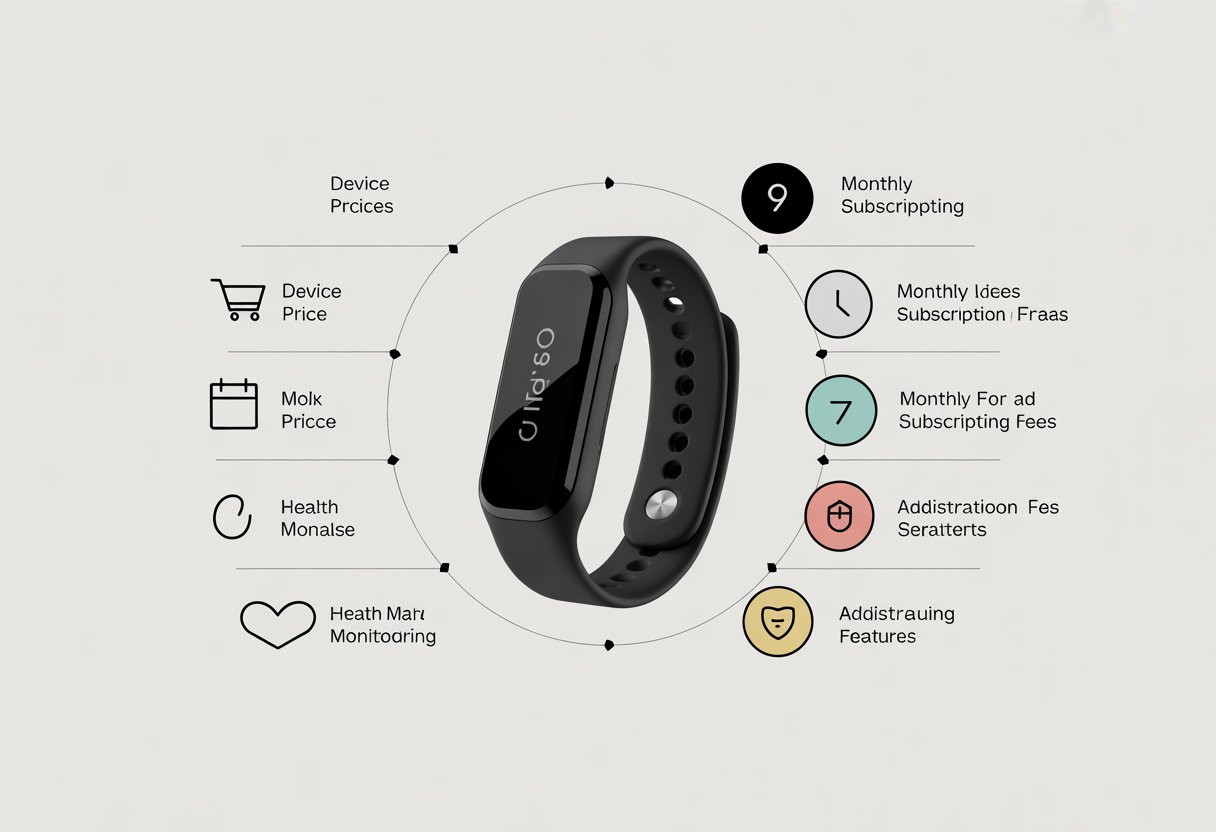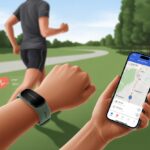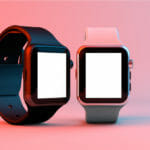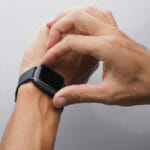So, you’re eyeing the Whoop club and wondering what the subscription will actually cost you. You’re not alone—untangling wearable prices is like sorting through a mess of holiday lights you swore you packed neatly last year.
WHOOP subscriptions start at $25 a month for the basic plan, and go up to $40 a month for the fanciest membership. (You can check the full breakdown here.) That’s just for the service—you don’t pay extra upfront for the device, but don’t skip the fine print.

You’ll see options like monthly or annual plans, and you can save a few bucks if you pay for a year. There are even tiers—because Whoop knows you love choices—like WHOOP One, Peak, and Life, each with their own features and prices.
Your subscription can match your budget and how serious you are about tracking every step (or nap). Whether you’re super dedicated or just curious about your sleep and recovery, there’s a Whoop plan for you.
What Is a WHOOP Subscription?
A WHOOP subscription gives you access to a high-tech fitness tracker, advanced metrics, and a slick app—but not, sadly, an actual whooping sound. It lets you dig into your health and fitness data, from morning grogginess to late-night snack regret.
Features Included
When you sign up for WHOOP, you get more than a wristband. The WHOOP 4.0 tracker comes with your subscription, so you can start pretending you’re a secret agent right away.
You’ll also get access to the WHOOP app, which beams all your tracked metrics straight to your phone. The app makes everything look like a science experiment, which is kind of fun.
Your subscription covers automatic data syncing, 24/7 heart rate monitoring, skin temperature readings, and sleep analysis. You also get in-depth activity tracking and strain scoring, so you’ll finally know if that “brisk” walk counted for anything.
Special WHOOP apparel lets you wear the sensor in your clothes, not just on your wrist. Teams and competitive challenges in the app add some motivation—or just give you someone to blame.
Supported Devices
WHOOP 4.0 works with both iOS and Android devices, so unless you’re still using a flip phone, you’re good. Download the app (free to install, not free to use) on your smartphone or tablet.
Pair your WHOOP with Bluetooth, stare at your new graphs, and maybe check your heart rate at dramatic moments. The tracker syncs with select third-party fitness apps and some smartwatches, making it a decent team player.
Your data follows you everywhere, from morning runs to late-night TV marathons. The WHOOP sensor is water-resistant and built for all-day wear, so you can even shower or swim with it.
Key Metrics Tracked
WHOOP tracks metrics that sound crucial—even if you mostly use them as an excuse for an afternoon nap. It constantly monitors your heart rate with a solid heart rate sensor, plus skin temperature for recovery and readiness.
Sleep is a big one: the system rates your sleep quality, hours slept, and how often you wake up. Activity tracking is at the core.
The tracker logs movement all day, classifies your activity (running, walking, searching for your keys), and gives you a strain score for how hard your body worked. The recovery score tells you if you’re ready for the next challenge—or just a coffee.
With all these numbers, you’ll know if your energy is superhero-level or “needs coffee, stat.”
WHOOP Subscription Cost Breakdown
You’re thinking about joining the WHOOP club, but your wallet wants the details. Here’s what you’ll pay, what options you have, and what’s extra—all broken down for minimum math headaches.
Monthly and Annual Pricing
WHOOP’s subscription comes at different price points, depending on how long you want to commit. If you’d rather not commit, you’ll pay $30 each month.
If you’re ready to stick around for at least a year, the annual plan is $239 upfront (about $20 per month). There’s even a 24-month plan that lowers your monthly cost if you’re really serious about your heart rate.
Here’s the short list:
- $30 per month (pay monthly)
- $239 per year (pay yearly, about $20/month)
- Other plans may pop up for longer periods
Check the WHOOP Membership Options page for official prices and deals. Your bank account will thank you.
Commitment Options
WHOOP wants you to commit—not to a person, but to your health stats.
You get three main choices:
- Monthly: Cancel whenever (but it costs more per month).
- Annual: Pay up front and save over 12 months.
- Two-year/18 month: Sometimes available, with even lower rates (the fine print reveals discounts for the truly committed).
The longer you commit, the less you pay per month. If you’re wary of wearable tech, go monthly. If you’re all in, the prepay discount is tempting.
Cost of the whoop strap
The latest WHOOP strap—currently Whoop 5.0 or Whoop 4.0 depending on supply—comes included in your subscription. No extra upfront cost for the device itself.
If you lose it, want a new color, or need extra bands, you’ll buy those separately. Replacement bands and accessories are on the WHOOP website.
So, you’re basically renting the magic wristband with your subscription. It’s a fitness tracker and a fashion statement—until you misplace it.
Add-Ons and Upgrades
WHOOP offers add-ons and upgrades if you want to step up your tracking. You can buy extra battery packs, swappable bands, or upgrade to a new device if you want the latest features before your subscription ends.
Sometimes, premium features or new sensor capabilities cost extra or come with higher-tier plans, like the new WHOOP Peak or WHOOP Life memberships. These start at $30 to $40 per month for more analytics and goodies, as listed on the WHOOP Support pricing page.
If you want personalized coaching or perks, those usually aren’t free. Your wrist gets smarter, but your credit card gets a workout.
Comparing WHOOP Subscription to Competitors
You’ve got options when it comes to tracking your health. Each device and subscription has its quirks—like picking friends, but with more heart rate data.
oura ring
Want to track your sleep and stress without a gadget on your wrist? The Oura Ring is like the James Bond of fitness trackers—sleek, hidden, and not exactly cheap.
You buy the ring once, then pay about $6 a month for a membership to unlock deeper data. You’ll get insights on sleep, readiness, and activity, but no GPS or step-by-step workout tracking.
Battery life? About 4-7 days, so you’ll charge less and glance at your finger more. If you want something discreet but powerful, Oura is aiming for deep health feedback—without the wrist tan line.
apple watch
Want a literal smart watch? Apple Watch mixes health tracking with every notification your phone already gives you.
The device can cost several hundred dollars, and there’s no required monthly fee—unless you go premium with Apple Fitness+. Apple Fitness+ runs about $10 per month.
Standard Apple Watch features include step tracking, heart rate monitoring, GPS, and those “remind you to breathe” alerts. You’ll also get messages, calls, and maybe a reminder to stand up when you just sat down.
Battery life is short—1-2 days—so you’ll get close to your charging cable. If you want a hybrid smartwatch and fitness tool, and you’re already in the Apple world, this makes sense.
fitbit
Fitbit’s been in the step-counting game longer than your knees have been cracking. The device is cheaper than an Apple Watch, and you get basics with no required subscription.
Fitbit Premium costs about $10 per month and unlocks deeper insights, advanced sleep tools, and guided programs. You can track your heart rate, steps, GPS runs (on some models), and even manage stress.
Battery life is solid—5 days for most models—so you might forget where your charger is. Fitbit is friendly for folks who want simple tracking and motivation without much fuss.
garmin
Garmin is for you if you want more stats than a baseball card. Most Garmin devices cost a few hundred dollars upfront, but you don’t need a subscription for core functions.
You get GPS built in, workout profiles, and deep analytics for running, cycling, swimming, and more. Some models measure your blood oxygen levels.
Battery life can stretch to 6-14 days, depending on GPS use. Garmin Coach offers training plans, but there’s no big push for a subscription fee.
If you’re training for an event or just love data dashboards, Garmin could be your new best friend.
Health & Recovery Insights with WHOOP
With WHOOP, you can track your sleep, how your body recovers, and how hard you push during workouts. You’ll get numbers and charts that might make your gym teacher jealous.
WHOOP takes the guesswork out of deciding if you should train hard or just take a nap.
Sleep Analysis
Your sleep matters more than you’d think. With WHOOP’s Sleep Analysis, you get a detailed look at how you slept last night.
The system tracks your total time asleep, sleep cycles, and how much deep sleep you managed to get. You’ll see when you entered light, deep, and REM sleep.
WHOOP even tracks how long it took you to fall asleep. So if those late-night YouTube binges are messing with your bedtime, you’ll know.
The tracker measures resting heart rate and heart rate variability while you sleep. This helps you spot when your body might need more rest than usual.
You’ll get a Sleep Performance Percentage score. It compares how much rest you needed versus what you actually got.
Recovery Score
Recovery Score is WHOOP’s way of telling you if your body’s recharged or if you should skip that extra round of burpees. You’ll get this score every morning, based on your sleep data, resting heart rate, and heart rate variability.
A high Recovery Score (green zone) means you’re ready for action. If you’re in the yellow or red, your body probably needs more rest—or maybe just a nap, honestly.
This score helps you spot trends in your recovery. You’ll learn what helps you bounce back, whether it’s more sleep, eating better, or fewer late nights.
You’ll also get tips on how to improve your score. Sometimes that means dialing back your workout or tweaking your bedtime routine.
It’s kind of like having a coach who doesn’t yell at you, but still keeps you honest.
Strain Monitoring
Strain Monitoring shows how hard you push yourself each day. WHOOP gives you a Strain Score, tracking your training load and daily physical activity.
This number ranges from 0 to 21. Higher numbers mean heavier loads.
WHOOP looks at your heart rate during workouts and combines this with recovery data. You’ll get a recommendation on how hard to go.
Maybe you’ve done enough and can relax, or maybe you can ramp things up. It’s a reality check, in a good way.
You can monitor your strain in real-time using the WHOOP app. It’s a bit like having a fitness backseat driver.
This helps you avoid overtraining and burnout. You’ll see the balance between effort and rest, which is honestly pretty useful.
WHOOP’s Advanced Metrics and Coaching
WHOOP offers detailed health data and personalized coaching tools. These features help you figure out your body during workouts, rest, and even while you sleep.
Real-Time Heart Rate Data
You’ll get real-time heart rate data. So yes, you can finally see how fast your heart races when you read the ice cream label.
WHOOP measures your heart rate 24/7. You get up-to-the-second info during workouts, daily activities, and sleep.
You’ll see your heart rate zones, making it easier to track how hard you’re training—or just how stressed you get before a big meeting.
The app gives you color-coded graphs and easy-to-read charts. You can spot patterns and trends, or notice when your heart rate is out of whack.
It’s handy for keeping tabs on your health, whether you’re running, lifting, or just hauling groceries.
Strain Coach
The Strain Coach is like a friendly drill sergeant in your pocket—minus the yelling. This feature tracks your effort by combining heart rate and activity duration into one overall strain score.
It ranges from 0 to 21. Higher numbers mean you’re working harder.
During workouts, Strain Coach gives you live feedback. It suggests what level of strain is optimal.
No more guessing if you’re being lazy or pushing it enough. It uses your recent recovery and sleep data, so its advice actually fits you.
Want to know if you’re working too hard or not enough? Strain Coach spells it out, so you don’t have to guess.
Respiratory Rate & Skin Temperature
WHOOP also measures your respiratory rate and skin temperature while you sleep. You’ll find out if you breathe like a zen master or a hyperactive squirrel.
Respiratory rate is just breaths per minute. Odd changes can be early signs of illness or fatigue.
Skin temperature trends are tracked each night. If your body temp jumps, WHOOP lets you know, which could mean stress, illness, or maybe just too much spicy food.
You’ll see this info in simple graphs. No medical degree required.
It’s an easy way to keep an eye on your well-being—no need to check your forehead every five minutes.
Battery Life & Durability
Most people want a fitness tracker that doesn’t need a daily charge or freak out at a splash of water. WHOOP’s got your back in both departments.
Battery Life Expectations
The WHOOP battery lasts up to 14 days on one charge if you’re using the WHOOP Life plan. That’s great if you hate charging things.
For other plans, you’ll get about five days between charges. Still long enough to lose your charger in the couch cushions.
The WHOOP comes with a battery pack that slips onto the strap. You can keep wearing it while it charges.
You won’t miss a step, a heartbeat, or your late-night snack run. Just remember to charge the battery pack itself, or you’ll be out of luck.
If you want the nitty-gritty, check out the WHOOP membership comparison for battery perks by plan.
Waterproof Features
No need for a dramatic slow-motion sprint if you forget to take off your WHOOP in the shower. The WHOOP is water-resistant and can handle swimming, showers, and sweaty workouts.
It meets the IP68 and 10 ATM rating. Pool laps and rainy bike rides won’t fry your tracker.
The waterproof rating means you can dive up to 100 meters. Not that you’re hunting Atlantis, but WHOOP could handle it.
Hot tubs and saunas, though? Not a good idea. Just leave it on the towel while you chill.
Rinse your band after a pool session. Chlorine’s great for pools, not so much for smart tech.
It’s not required, but your WHOOP will appreciate the spa day.
Maintenance & Upkeep
Taking care of your WHOOP is simple and saves you headaches later. Clean the band often, especially after sweaty workouts or saltwater.
Use plain water and a soft cloth. Skip the harsh cleaners—your WHOOP isn’t into rebellion.
If the band wears out or the clasp acts up, you can replace the band without tossing the device. Battery packs don’t last forever, so if you notice shorter battery life, it’s probably time for a new one.
Keep your charging contacts dry and free of sweat gunk. Your wrist can be wild, but your WHOOP likes a little care.
Customization and Integration
Whoop isn’t just a strap quietly judging your sleep schedule—it’s a whole system you can set up to fit your life. You can pick out stylish gear, sync data to your favorite fitness apps, and keep tabs on everything from bike rides to fridge raids.
Apparel & Accessories
You get to wear the Whoop strap like a badge of activity—or at least a sleek wristband. There’s a range of bands, sleeves, and even high-tech boxers designed to fit the sensor.
You can monitor your stats and still look like you didn’t just roll out of the gym. Accessories include different colors and materials like silicone, leather, and SuperKnit.
Swapping straps is easy, so you can match your mood, your outfit, or your workout. The best part: you get to feel techy and trendy, which is a rare combo.
Extra apparel options let you wear the sensor in new ways. Slip it into a special arm sleeve for sports, or into compatible underwear if you want less wrist drama while you sleep.
Data Syncing and Strava Integration
If you use Strava, you’ll love that Whoop works with it. Once you link accounts, Whoop auto-uploads your activities.
Your morning jog gets logged without any extra effort. Whoop syncs its data with your phone using Bluetooth.
You just open the app—no engineering degree needed. Stats like heart rate, calories burned, and sleep performance show up in the app.
You can review all your fitness stats right inside the Strava feed. Your data lives in one place.
If you like competing on Strava segments, this makes it easier to flex your best scores and still track your health data.
Cycle & Activity Tracking
Whoop isn’t just about steps. You get deep cycle tracking for sleep, workouts, and recovery, so your rest days actually count.
The tracker monitors your heart rate, strain, and recovery. You can log every run, ride, or even those spontaneous dance parties.
The cycle tracking feature helps you spot trends in your activity and recovery. You’ll finally see how much effort that “easy” ride really took.
Swiping through your weekly report, you’ll see why you need another coffee by Thursday. Whoop even auto-detects some workouts, so you don’t have to remember to log them.
For cyclists, you’ll see distance, duration, and effort for every ride. All that info is easy to check in your dashboard.
Perfect for tracking gains—or justifying an extra slice of cake.
Lifestyle Factors Impacting Data Accuracy
Your daily habits can play tricks on your WHOOP data. Everything from that extra cup of coffee to your sleep routine changes what you see in the app.
Caffeine and Alcohol
Caffeine is the little engine that could—until it messes with your WHOOP readings. Drink coffee too late, and your heart rate might stay high at bedtime.
That late-night espresso? It can mess with both your recovery score and sleep quality.
Alcohol isn’t any better. Even one drink can lead to weird heart rate numbers and less restful sleep.
Your WHOOP will probably show lower recovery stats, since alcohol messes with deep sleep and heart rate variability. If you party, expect your “Strain” numbers to give you the side-eye the next day.
Here’s a quick list:
- Caffeine late in the day = higher heart rate at night
- Alcohol = lower recovery and more “what happened last night?” stats
- Both can make your data less reliable
So, yeah, your nightly glass of wine does more than make you chatty at dinner.
Sleep Hygiene Tips
Who knew clean sheets aren’t the only thing that matters? Good sleep hygiene is about routines that help you rest better and make your WHOOP more accurate.
If you keep going to bed at random times, your sleep stages might look more like a roller coaster.
Try these tips:
- Same bedtime and wake-up time—even on weekends.
- No screens at least 30 minutes before bed.
- Keep your room cool and dark.
A steady sleep routine lets your WHOOP track your heart rate and deep sleep more reliably. You’ll get data that actually makes sense—and probably a few less surprises.
- Best Bluetooth Headphones for Airplane Travel: Drown Out Crying Babies in Style - December 8, 2025
- How to use Bluetooth headphones with an intercom system and Finally Escape Tangled Wires - December 7, 2025
- Best Fitness Trackers for Silent Alarms: Wake Up Without the Drama - December 7, 2025






